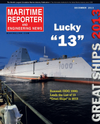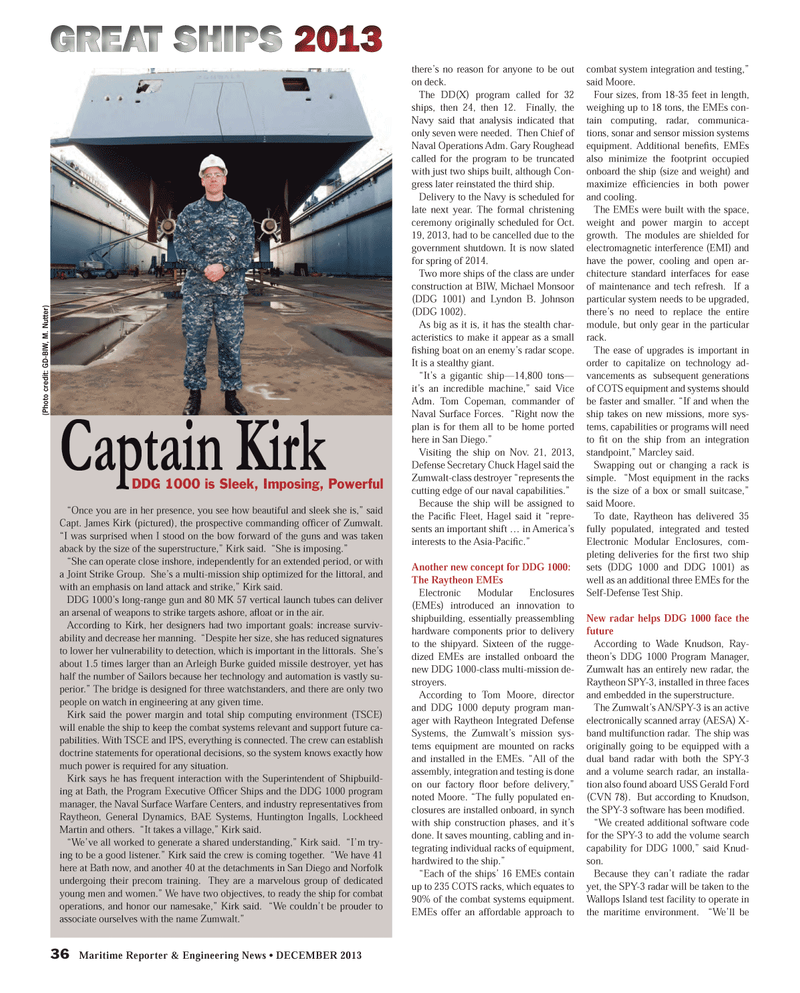
Page 36: of Maritime Reporter Magazine (December 2013)
Great Ships of 2013
Read this page in Pdf, Flash or Html5 edition of December 2013 Maritime Reporter Magazine
36 Maritime Reporter & Engineering News ? DECEMBER 2013 there?s no reason for anyone to be out on deck.The DD(X) program called for 32 ships, then 24, then 12. Finally, the Navy said that analysis indicated that only seven were needed. Then Chief of Naval Operations Adm. Gary Roughead called for the program to be truncated with just two ships built, although Con-gress later reinstated the third ship.Delivery to the Navy is scheduled for late next year. The formal christening ceremony originally scheduled for Oct. 19, 2013, had to be cancelled due to the government shutdown. It is now slated for spring of 2014.Two more ships of the class are under construction at BIW, Michael Monsoor (DDG 1001) and Lyndon B. Johnson (DDG 1002).As big as it is, it has the stealth char- acteristics to make it appear as a small Þ shing boat on an enemy?s radar scope. It is a stealthy giant.?It?s a gigantic ship?14,800 tons? it?s an incredible machine,? said Vice Adm. Tom Copeman, commander of Naval Surface Forces. ?Right now the plan is for them all to be home ported here in San Diego.?Visiting the ship on Nov. 21, 2013, Defense Secretary Chuck Hagel said the Zumwalt-class destroyer ?represents the cutting edge of our naval capabilities.?Because the ship will be assigned to the PaciÞ c Fleet, Hagel said it ?repre- sents an important shift ? in America?s interests to the Asia-Paci Þ c.?Another new concept for DDG 1000: The Raytheon EMEsElectronic Modular Enclosures (EMEs) introduced an innovation to shipbuilding, essentially preassembling hardware components prior to delivery to the shipyard. Sixteen of the rugge-dized EMEs are installed onboard the new DDG 1000-class multi-mission de-stroyers.According to T om Moore, director and DDG 1000 deputy program man-ager with Raytheon Integrated Defense Systems, the Zumwalt?s mission sys- tems equipment are mounted on racks and installed in the EMEs. ?All of the assembly, integration and testing is done on our factory ß oor before delivery,? noted Moore. ?The fully populated en-closures are installed onboard, in synch with ship construction phases, and it?s done. It saves mounting, cabling and in-tegrating individual racks of equipment, hardwired to the ship.? ?Each of the ships? 16 EMEs contain up to 235 COTS racks, which equates to 90% of the combat systems equipment. EMEs offer an affordable approach to combat system integration and testing,? said Moore. Four sizes, from 18-35 feet in length, weighing up to 18 tons, the EMEs con-tain computing, radar, communica- tions, sonar and sensor mission systems equipment. Additional bene Þ ts, EMEs also minimize the footprint occupied onboard the ship (size and weight) and maximize efÞ ciencies in both power and cooling.The EMEs were built with the space, weight and power margin to accept growth. The modules are shielded for electromagnetic interference (EMI) and have the power, cooling and open ar- chitecture standard interfaces for ease of maintenance and tech refresh. If a particular system needs to be upgraded, there?s no need to replace the entire module, but only gear in the particular rack. The ease of upgrades is important in order to capitalize on technology ad-vancements as subsequent generations of COTS equipment and systems should be faster and smaller. ?If and when the ship takes on new missions, more sys-tems, capabilities or programs will need to Þ t on the ship from an integration standpoint,? Marcley said.Swapping out or changing a rack is simple. ?Most equipment in the racks is the size of a box or small suitcase,? said Moore. To date, Raytheon has delivered 35 fully populated, integrated and tested Electronic Modular Enclosures, com-pleting deliveries for the Þ rst two ship sets (DDG 1000 and DDG 1001) as well as an additional three EMEs for the Self-Defense Test Ship. New radar helps DDG 1000 face the future According to Wade Knudson, Ray- theon?s DDG 1000 Program Manager , Zumwalt has an entirely new radar, the Raytheon SPY-3, installed in three faces and embedded in the superstructure.The Zumwalt?s AN/SPY-3 is an active electronically scanned array (AESA) X-band multifunction radar. The ship was originally going to be equipped with a dual band radar with both the SPY-3 and a volume search radar, an installa- tion also found aboard USS Gerald Ford (CVN 78). But according to Knudson, the SPY-3 software has been modi Þ ed.?We created additional software code for the SPY-3 to add the volume search capability for DDG 1000,? said Knud-son. Because they can?t radiate the radar yet, the SPY-3 radar will be taken to the Wallops Island test facility to operate in the maritime environment. ?We?ll be Captain Kirk ?Once you are in her presence, you see how beautiful and sleek she is,? said Capt. James Kirk (pictured), the prospective commanding ofÞ cer of Zumwalt. ?I was surprised when I stood on the bow forward of the guns and was taken aback by the size of the superstructure,? Kirk said. ?She is imposing.??She can operate close inshore, independently for an extended period, or with a Joint Strike Group. She?s a multi-mission ship optimized for the littoral, and with an emphasis on land attack and strike,? Kirk said.DDG 1000?s long-range gun and 80 MK 57 vertical launch tubes can deliver an arsenal of weapons to strike targets ashore, a ß oat or in the air. According to Kirk, her designers had two important goals: increase surviv-ability and decrease her manning. ?Despite her size, she has reduced signatures to lower her vulnerability to detection, which is important in the littorals. She?s about 1.5 times larger than an Arleigh Burke guided missile destroyer, yet has half the number of Sailors because her technology and automation is vastly su-perior.? The bridge is designed for three watchstanders, and there are only two people on watch in engineering at any given time.Kirk said the power margin and total ship computing environment (TSCE) will enable the ship to keep the combat systems relevant and support future ca-pabilities. With TSCE and IPS, everything is connected. The crew can establish doctrine statements for operational decisions, so the system knows exactly how much power is required for any situation. Kirk says he has frequent interaction with the Superintendent of Shipbuild-ing at Bath, the Program Executive OfÞ cer Ships and the DDG 1000 program manager, the Naval Surface Warfare Centers, and industry representatives from Raytheon, General Dynamics, BAE Systems, Huntington Ingalls, Lockheed Martin and others. ?It takes a village,? Kirk said.?We?ve all worked to generate a shared understanding,? Kirk said. ?I?m try- ing to be a good listener.? Kirk said the crew is coming together. ?We have 41 here at Bath now, and another 40 at the detachments in San Diego and Norfolk undergoing their precom training. They are a marvelous group of dedicated young men and women.? We have two objectives, to ready the ship for combat operations, and honor our namesake,? Kirk said. ?We couldn?t be prouder to associate ourselves with the name Zumwalt.?DDG 1000 is Sleek, Imposing, Powerful(Photo credit: GD-BIW, M. Nutter) MR #12 (34-41).indd 36MR #12 (34-41).indd 3612/9/2013 10:47:37 AM12/9/2013 10:47:37 AM

 35
35

 37
37
